Performance Management Analysis: Attorney General Office Report
VerifiedAdded on 2020/03/01
|20
|4855
|68
Report
AI Summary
This report delves into the critical aspects of performance management within the Attorney General Office (AGO). It begins by defining performance management and its significance in contemporary organizations, highlighting the importance of employee development and performance appraisals. The report identifies flaws in the existing system, such as unclear goals and lack of feedback, and explores relevant theories like Goal Setting Theory, Control Theory, and Social Cognitive Theory, which can be utilized to improve performance management. It examines the impact of these theories on employee motivation and performance, while also referencing the management principles of Henry Fayol and Peter Drucker. Furthermore, it emphasizes the close relationship between performance management and employee development, outlining the stages of performance management and its role in organizational success. Finally, the report concludes by identifying the causes of the current issues and suggests recommendations for improvement within the AGO, based on the analysis of the existing literature and organizational practices.

Running head: PERFORMANCE MANAGEMENT
Performance Management
Name of the Student
Name of the University
Author note
Performance Management
Name of the Student
Name of the University
Author note
Paraphrase This Document
Need a fresh take? Get an instant paraphrase of this document with our AI Paraphraser
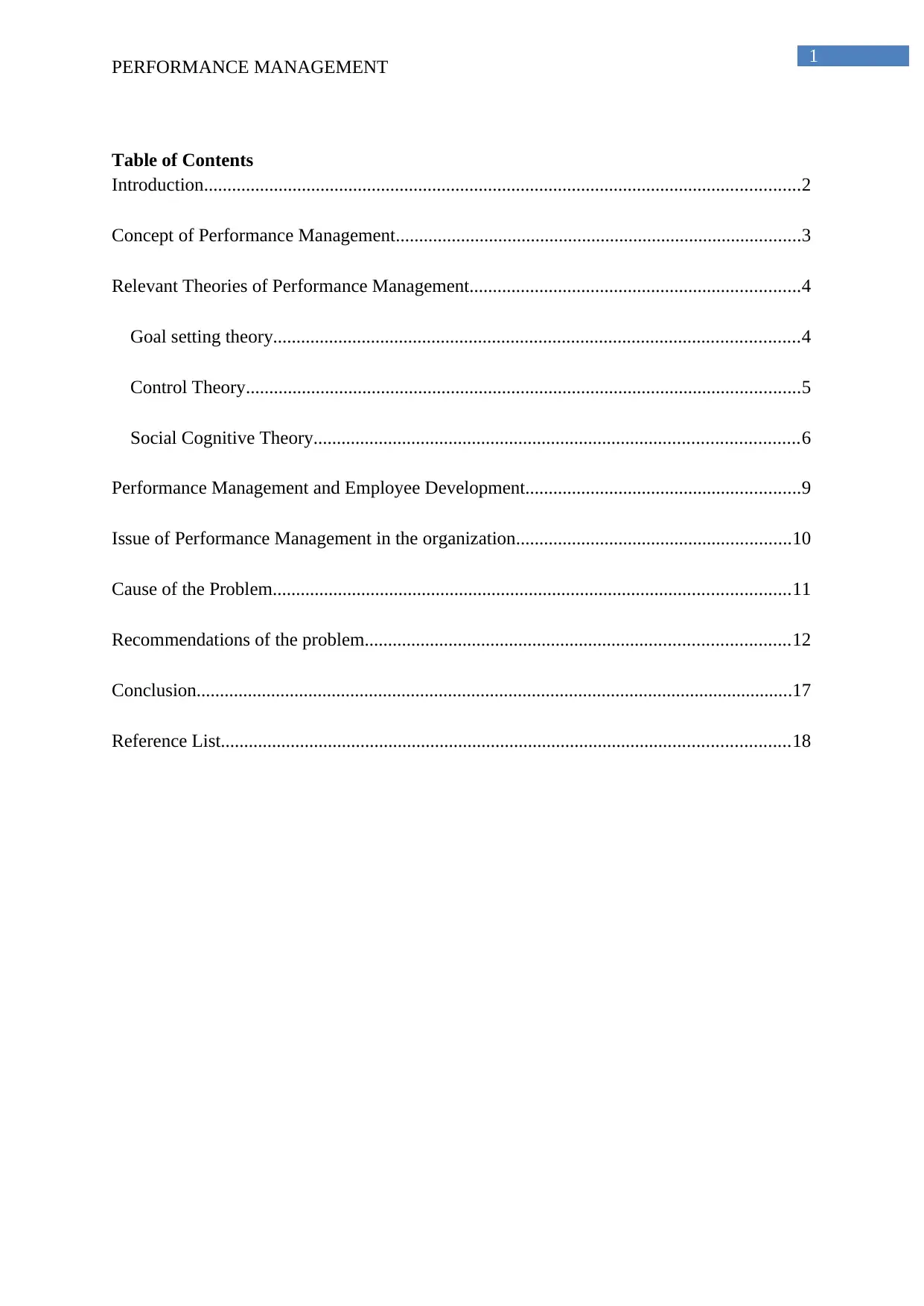
1
PERFORMANCE MANAGEMENT
Table of Contents
Introduction................................................................................................................................2
Concept of Performance Management.......................................................................................3
Relevant Theories of Performance Management.......................................................................4
Goal setting theory.................................................................................................................4
Control Theory.......................................................................................................................5
Social Cognitive Theory........................................................................................................6
Performance Management and Employee Development...........................................................9
Issue of Performance Management in the organization...........................................................10
Cause of the Problem...............................................................................................................11
Recommendations of the problem...........................................................................................12
Conclusion................................................................................................................................17
Reference List..........................................................................................................................18
PERFORMANCE MANAGEMENT
Table of Contents
Introduction................................................................................................................................2
Concept of Performance Management.......................................................................................3
Relevant Theories of Performance Management.......................................................................4
Goal setting theory.................................................................................................................4
Control Theory.......................................................................................................................5
Social Cognitive Theory........................................................................................................6
Performance Management and Employee Development...........................................................9
Issue of Performance Management in the organization...........................................................10
Cause of the Problem...............................................................................................................11
Recommendations of the problem...........................................................................................12
Conclusion................................................................................................................................17
Reference List..........................................................................................................................18

2
PERFORMANCE MANAGEMENT
Introduction
Performance management has been a major part of the business strategy of the
organizations in the contemporary organization. The performance management system
mostly includes the employee development and the performance appraisals which are two of
the significant concerns of the human resource departments. However in reality most of the
organizations suffer from several flaws in this department, where the managers and the
employees lament regarding their ineffectiveness on a regular basis. In a recent survey in
Australia, around forty percent of the entire employees stated that the systems in their
organizations had established clear goals regarding their performance within the organization,
generate sincere feedback or utilized the technological advancements for helping the
employees in improving their performance (Van Dooren, Bouckaert. and Halligan2015). In
most cases the management system of the organizations indicate the performance
management system has been designed poorly, however, not only the poorly designed
processes and tools cause complicatedness, it is also due to the fact that in most of the
organizations, the performance management system is personal and it is quite a threatening
procedure for the employees and the managers. Similar thing has happened in the chosen
organization where the managers are not informing the employees regarding their poor
performance as they themselves know that the employees are not happy with their job. There
are numbers of organizations where the managers do not provide honest feedback and have
discussions with the employees due to their fear of damaged relationship within the
organization as they mostly count on these individuals for completing the work (Buckingham
and Goodall 2015). This report will trigger this very issue of performance management of the
staff lawyers who are working at the Attorney General Office (AGO). This study will also
demonstrate the relevant theories and models on this issue and after drawing necessary
PERFORMANCE MANAGEMENT
Introduction
Performance management has been a major part of the business strategy of the
organizations in the contemporary organization. The performance management system
mostly includes the employee development and the performance appraisals which are two of
the significant concerns of the human resource departments. However in reality most of the
organizations suffer from several flaws in this department, where the managers and the
employees lament regarding their ineffectiveness on a regular basis. In a recent survey in
Australia, around forty percent of the entire employees stated that the systems in their
organizations had established clear goals regarding their performance within the organization,
generate sincere feedback or utilized the technological advancements for helping the
employees in improving their performance (Van Dooren, Bouckaert. and Halligan2015). In
most cases the management system of the organizations indicate the performance
management system has been designed poorly, however, not only the poorly designed
processes and tools cause complicatedness, it is also due to the fact that in most of the
organizations, the performance management system is personal and it is quite a threatening
procedure for the employees and the managers. Similar thing has happened in the chosen
organization where the managers are not informing the employees regarding their poor
performance as they themselves know that the employees are not happy with their job. There
are numbers of organizations where the managers do not provide honest feedback and have
discussions with the employees due to their fear of damaged relationship within the
organization as they mostly count on these individuals for completing the work (Buckingham
and Goodall 2015). This report will trigger this very issue of performance management of the
staff lawyers who are working at the Attorney General Office (AGO). This study will also
demonstrate the relevant theories and models on this issue and after drawing necessary
⊘ This is a preview!⊘
Do you want full access?
Subscribe today to unlock all pages.

Trusted by 1+ million students worldwide
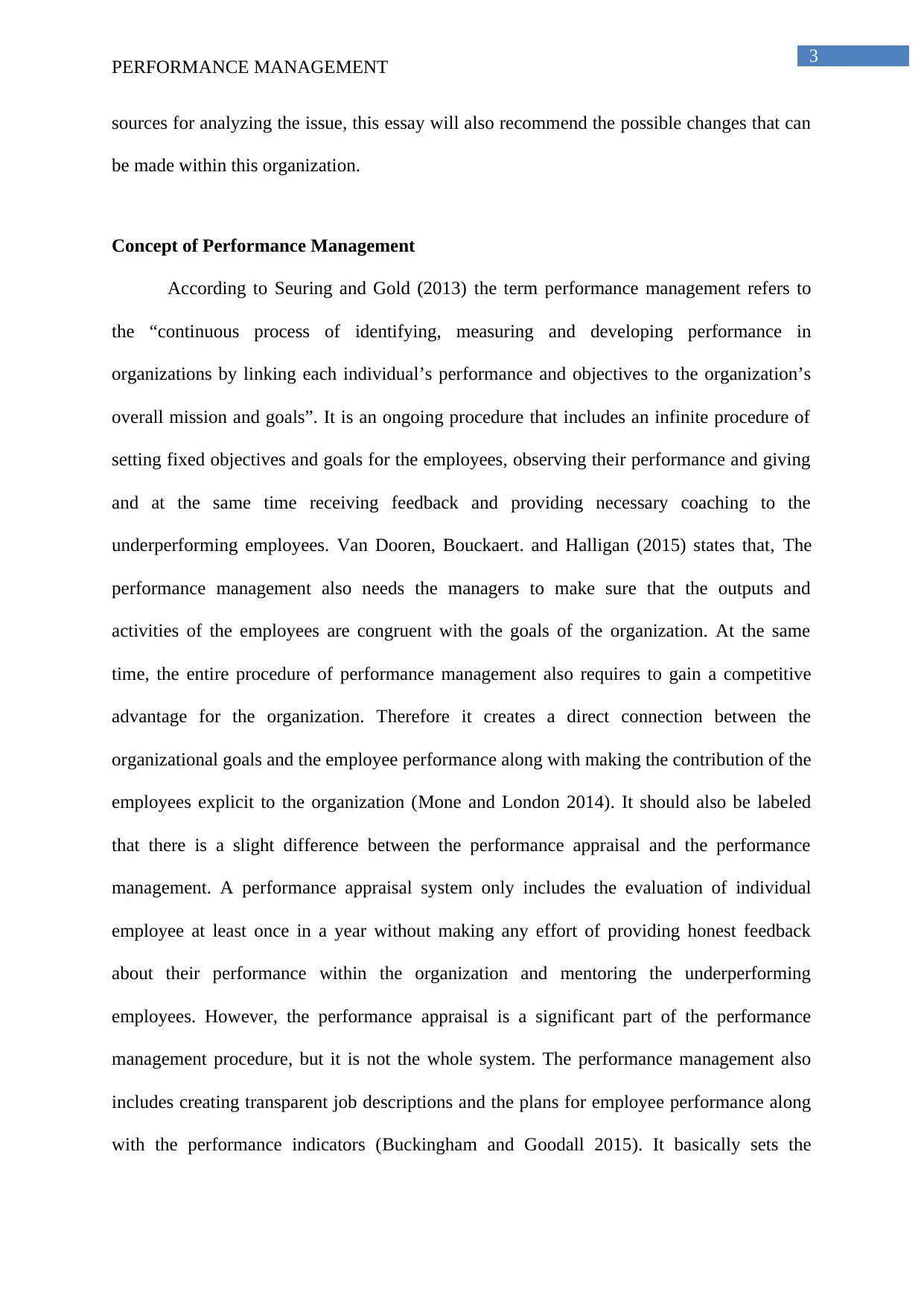
3
PERFORMANCE MANAGEMENT
sources for analyzing the issue, this essay will also recommend the possible changes that can
be made within this organization.
Concept of Performance Management
According to Seuring and Gold (2013) the term performance management refers to
the “continuous process of identifying, measuring and developing performance in
organizations by linking each individual’s performance and objectives to the organization’s
overall mission and goals”. It is an ongoing procedure that includes an infinite procedure of
setting fixed objectives and goals for the employees, observing their performance and giving
and at the same time receiving feedback and providing necessary coaching to the
underperforming employees. Van Dooren, Bouckaert. and Halligan (2015) states that, The
performance management also needs the managers to make sure that the outputs and
activities of the employees are congruent with the goals of the organization. At the same
time, the entire procedure of performance management also requires to gain a competitive
advantage for the organization. Therefore it creates a direct connection between the
organizational goals and the employee performance along with making the contribution of the
employees explicit to the organization (Mone and London 2014). It should also be labeled
that there is a slight difference between the performance appraisal and the performance
management. A performance appraisal system only includes the evaluation of individual
employee at least once in a year without making any effort of providing honest feedback
about their performance within the organization and mentoring the underperforming
employees. However, the performance appraisal is a significant part of the performance
management procedure, but it is not the whole system. The performance management also
includes creating transparent job descriptions and the plans for employee performance along
with the performance indicators (Buckingham and Goodall 2015). It basically sets the
PERFORMANCE MANAGEMENT
sources for analyzing the issue, this essay will also recommend the possible changes that can
be made within this organization.
Concept of Performance Management
According to Seuring and Gold (2013) the term performance management refers to
the “continuous process of identifying, measuring and developing performance in
organizations by linking each individual’s performance and objectives to the organization’s
overall mission and goals”. It is an ongoing procedure that includes an infinite procedure of
setting fixed objectives and goals for the employees, observing their performance and giving
and at the same time receiving feedback and providing necessary coaching to the
underperforming employees. Van Dooren, Bouckaert. and Halligan (2015) states that, The
performance management also needs the managers to make sure that the outputs and
activities of the employees are congruent with the goals of the organization. At the same
time, the entire procedure of performance management also requires to gain a competitive
advantage for the organization. Therefore it creates a direct connection between the
organizational goals and the employee performance along with making the contribution of the
employees explicit to the organization (Mone and London 2014). It should also be labeled
that there is a slight difference between the performance appraisal and the performance
management. A performance appraisal system only includes the evaluation of individual
employee at least once in a year without making any effort of providing honest feedback
about their performance within the organization and mentoring the underperforming
employees. However, the performance appraisal is a significant part of the performance
management procedure, but it is not the whole system. The performance management also
includes creating transparent job descriptions and the plans for employee performance along
with the performance indicators (Buckingham and Goodall 2015). It basically sets the
Paraphrase This Document
Need a fresh take? Get an instant paraphrase of this document with our AI Paraphraser
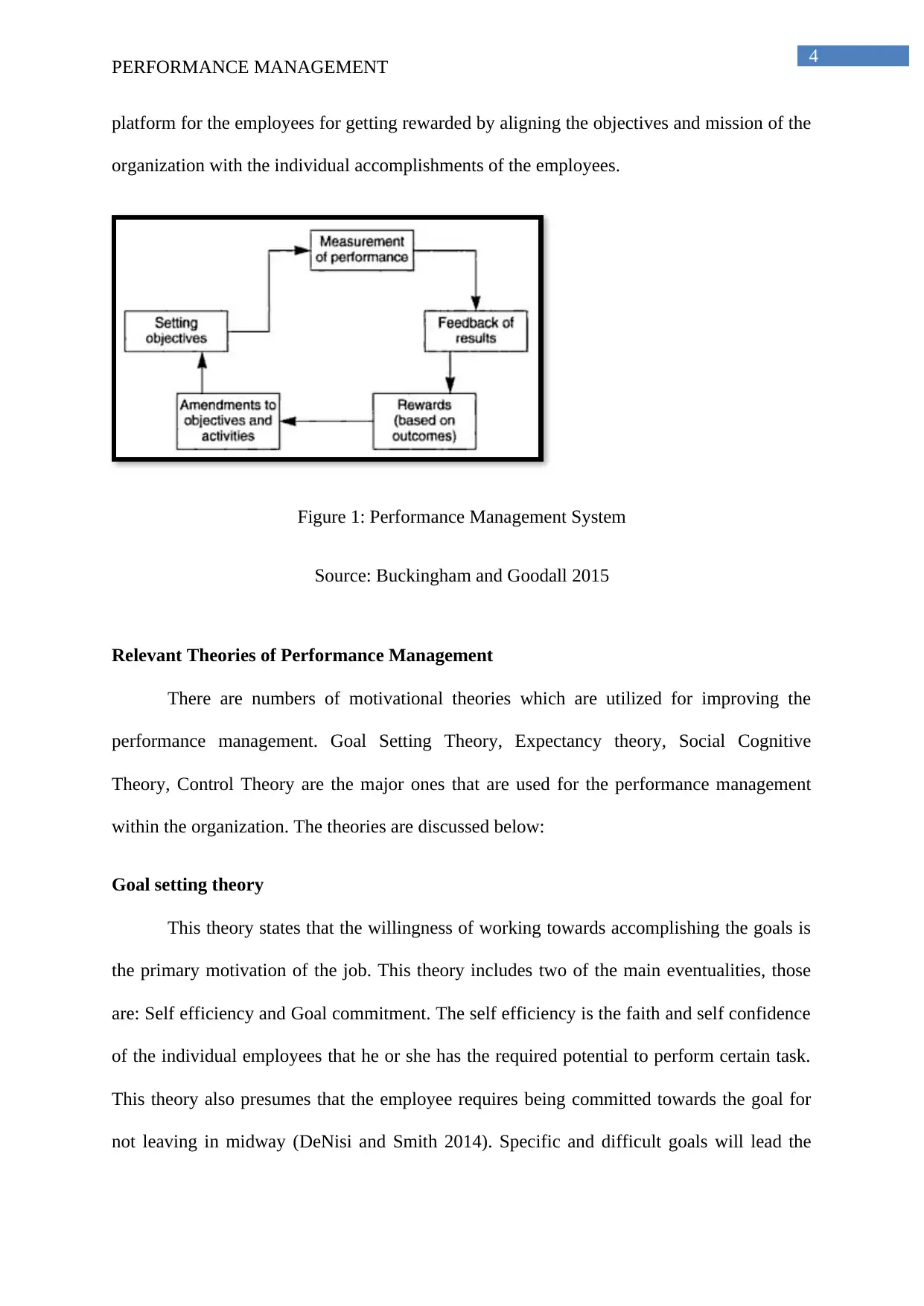
4
PERFORMANCE MANAGEMENT
platform for the employees for getting rewarded by aligning the objectives and mission of the
organization with the individual accomplishments of the employees.
Figure 1: Performance Management System
Source: Buckingham and Goodall 2015
Relevant Theories of Performance Management
There are numbers of motivational theories which are utilized for improving the
performance management. Goal Setting Theory, Expectancy theory, Social Cognitive
Theory, Control Theory are the major ones that are used for the performance management
within the organization. The theories are discussed below:
Goal setting theory
This theory states that the willingness of working towards accomplishing the goals is
the primary motivation of the job. This theory includes two of the main eventualities, those
are: Self efficiency and Goal commitment. The self efficiency is the faith and self confidence
of the individual employees that he or she has the required potential to perform certain task.
This theory also presumes that the employee requires being committed towards the goal for
not leaving in midway (DeNisi and Smith 2014). Specific and difficult goals will lead the
PERFORMANCE MANAGEMENT
platform for the employees for getting rewarded by aligning the objectives and mission of the
organization with the individual accomplishments of the employees.
Figure 1: Performance Management System
Source: Buckingham and Goodall 2015
Relevant Theories of Performance Management
There are numbers of motivational theories which are utilized for improving the
performance management. Goal Setting Theory, Expectancy theory, Social Cognitive
Theory, Control Theory are the major ones that are used for the performance management
within the organization. The theories are discussed below:
Goal setting theory
This theory states that the willingness of working towards accomplishing the goals is
the primary motivation of the job. This theory includes two of the main eventualities, those
are: Self efficiency and Goal commitment. The self efficiency is the faith and self confidence
of the individual employees that he or she has the required potential to perform certain task.
This theory also presumes that the employee requires being committed towards the goal for
not leaving in midway (DeNisi and Smith 2014). Specific and difficult goals will lead the
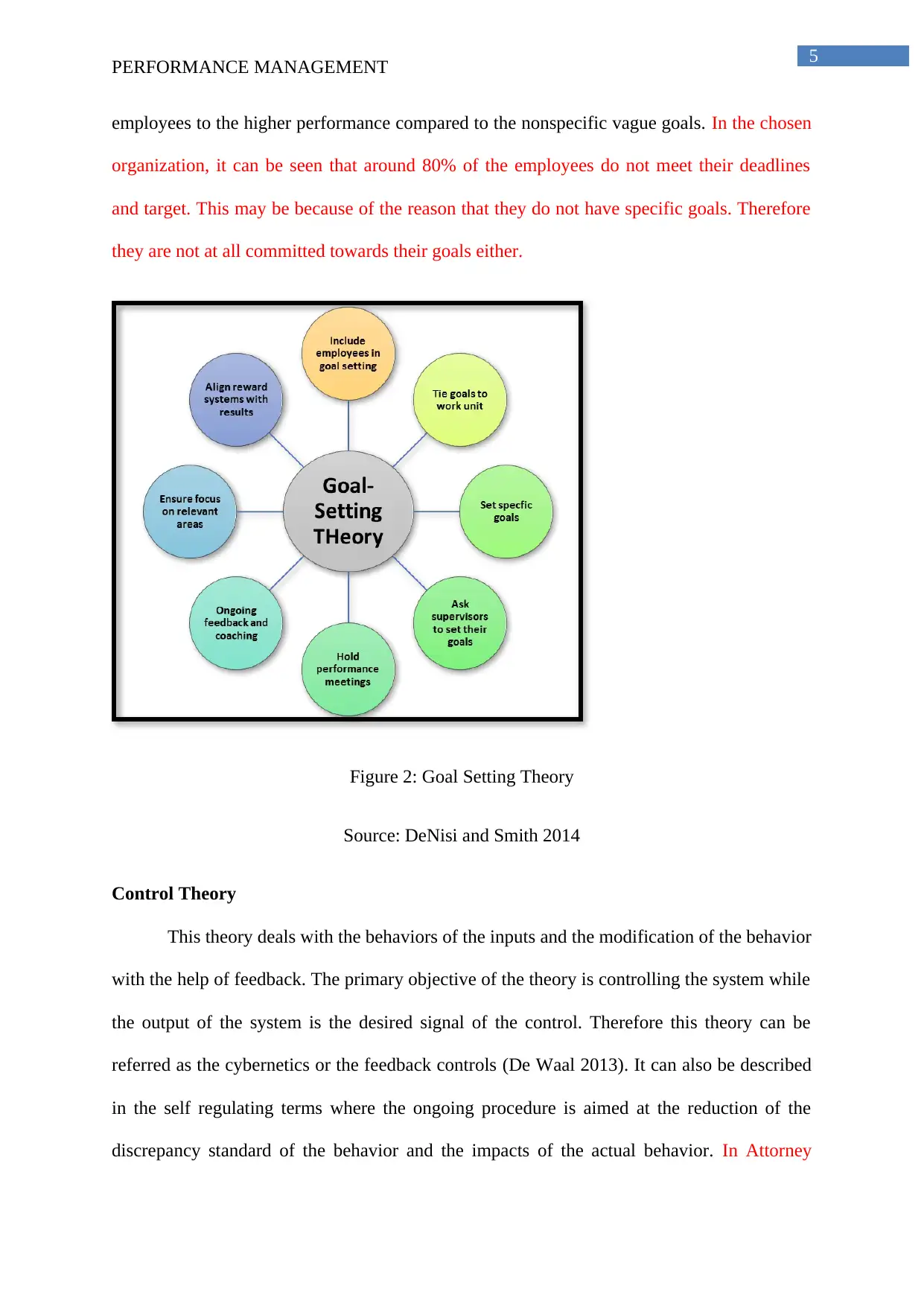
5
PERFORMANCE MANAGEMENT
employees to the higher performance compared to the nonspecific vague goals. In the chosen
organization, it can be seen that around 80% of the employees do not meet their deadlines
and target. This may be because of the reason that they do not have specific goals. Therefore
they are not at all committed towards their goals either.
Figure 2: Goal Setting Theory
Source: DeNisi and Smith 2014
Control Theory
This theory deals with the behaviors of the inputs and the modification of the behavior
with the help of feedback. The primary objective of the theory is controlling the system while
the output of the system is the desired signal of the control. Therefore this theory can be
referred as the cybernetics or the feedback controls (De Waal 2013). It can also be described
in the self regulating terms where the ongoing procedure is aimed at the reduction of the
discrepancy standard of the behavior and the impacts of the actual behavior. In Attorney
PERFORMANCE MANAGEMENT
employees to the higher performance compared to the nonspecific vague goals. In the chosen
organization, it can be seen that around 80% of the employees do not meet their deadlines
and target. This may be because of the reason that they do not have specific goals. Therefore
they are not at all committed towards their goals either.
Figure 2: Goal Setting Theory
Source: DeNisi and Smith 2014
Control Theory
This theory deals with the behaviors of the inputs and the modification of the behavior
with the help of feedback. The primary objective of the theory is controlling the system while
the output of the system is the desired signal of the control. Therefore this theory can be
referred as the cybernetics or the feedback controls (De Waal 2013). It can also be described
in the self regulating terms where the ongoing procedure is aimed at the reduction of the
discrepancy standard of the behavior and the impacts of the actual behavior. In Attorney
⊘ This is a preview!⊘
Do you want full access?
Subscribe today to unlock all pages.

Trusted by 1+ million students worldwide
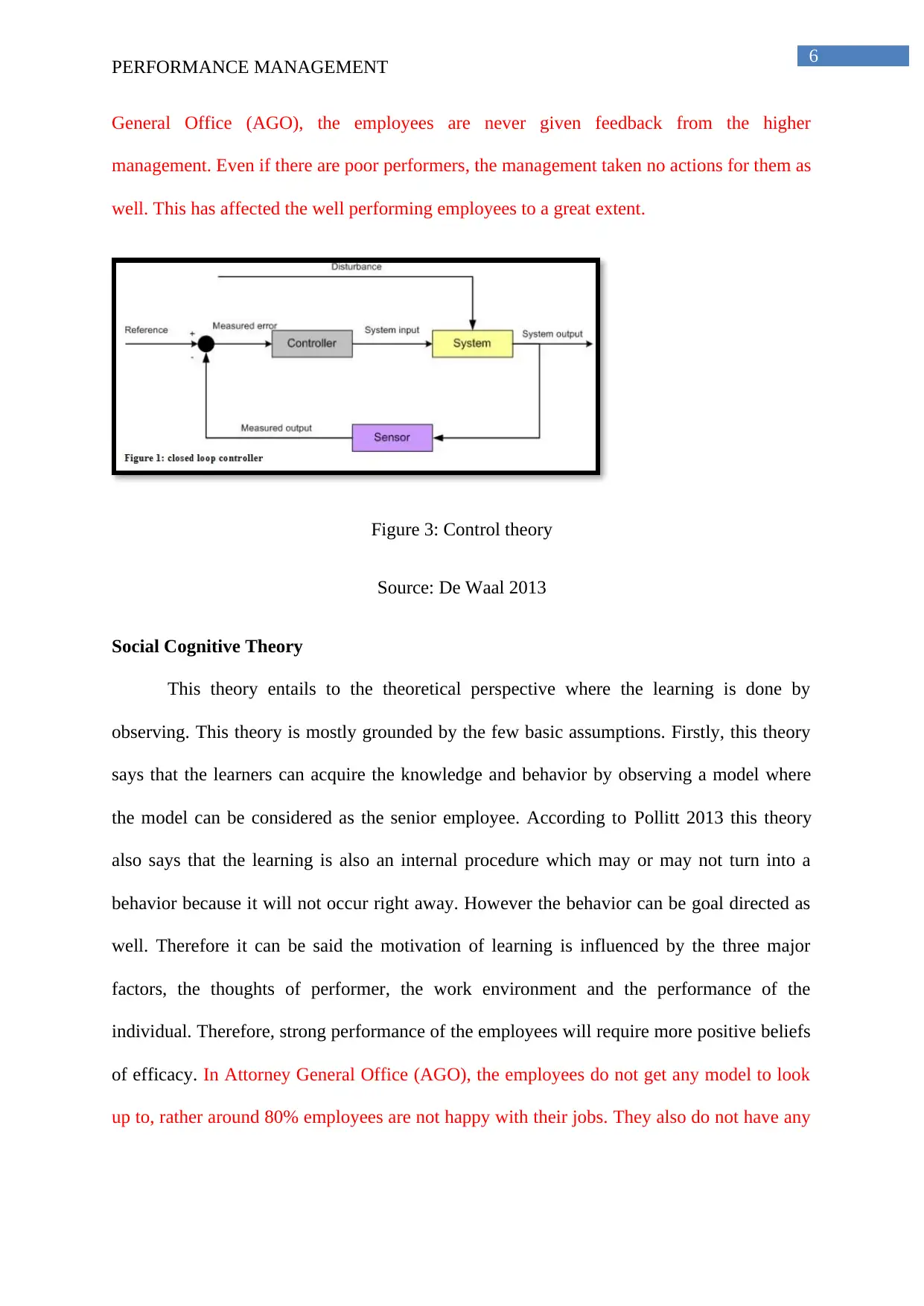
6
PERFORMANCE MANAGEMENT
General Office (AGO), the employees are never given feedback from the higher
management. Even if there are poor performers, the management taken no actions for them as
well. This has affected the well performing employees to a great extent.
Figure 3: Control theory
Source: De Waal 2013
Social Cognitive Theory
This theory entails to the theoretical perspective where the learning is done by
observing. This theory is mostly grounded by the few basic assumptions. Firstly, this theory
says that the learners can acquire the knowledge and behavior by observing a model where
the model can be considered as the senior employee. According to Pollitt 2013 this theory
also says that the learning is also an internal procedure which may or may not turn into a
behavior because it will not occur right away. However the behavior can be goal directed as
well. Therefore it can be said the motivation of learning is influenced by the three major
factors, the thoughts of performer, the work environment and the performance of the
individual. Therefore, strong performance of the employees will require more positive beliefs
of efficacy. In Attorney General Office (AGO), the employees do not get any model to look
up to, rather around 80% employees are not happy with their jobs. They also do not have any
PERFORMANCE MANAGEMENT
General Office (AGO), the employees are never given feedback from the higher
management. Even if there are poor performers, the management taken no actions for them as
well. This has affected the well performing employees to a great extent.
Figure 3: Control theory
Source: De Waal 2013
Social Cognitive Theory
This theory entails to the theoretical perspective where the learning is done by
observing. This theory is mostly grounded by the few basic assumptions. Firstly, this theory
says that the learners can acquire the knowledge and behavior by observing a model where
the model can be considered as the senior employee. According to Pollitt 2013 this theory
also says that the learning is also an internal procedure which may or may not turn into a
behavior because it will not occur right away. However the behavior can be goal directed as
well. Therefore it can be said the motivation of learning is influenced by the three major
factors, the thoughts of performer, the work environment and the performance of the
individual. Therefore, strong performance of the employees will require more positive beliefs
of efficacy. In Attorney General Office (AGO), the employees do not get any model to look
up to, rather around 80% employees are not happy with their jobs. They also do not have any
Paraphrase This Document
Need a fresh take? Get an instant paraphrase of this document with our AI Paraphraser

7
PERFORMANCE MANAGEMENT
integrated performance appraisal. This can be the primary reason for employees leaving the
organization after a certain point of time.
Figure 4: Social Cognitive Theory
Source: Pollitt 2013
Other than these theories, the concept of Henry Fayol has influenced several
organizations to shape their work methods. Fayol has stated that there are five elements in the
management. Those are:
Planning: Setting the aims and objectives and the policies, strategies and procedures
for achieving them.
Organizing: Setting the jobs for achieving the objectives. Along with that, task
allocation to the individuals or the groups for empowering the employees who are
responsible for the specific jobs (Van Dooren, Bouckaert. and Halligan 2015).
Commanding: Instructing the employees for carrying out the task.
Coordinating: Making sure that there is only one shared and common approach for all
the groups for meeting the objective and aim of the organization.
PERFORMANCE MANAGEMENT
integrated performance appraisal. This can be the primary reason for employees leaving the
organization after a certain point of time.
Figure 4: Social Cognitive Theory
Source: Pollitt 2013
Other than these theories, the concept of Henry Fayol has influenced several
organizations to shape their work methods. Fayol has stated that there are five elements in the
management. Those are:
Planning: Setting the aims and objectives and the policies, strategies and procedures
for achieving them.
Organizing: Setting the jobs for achieving the objectives. Along with that, task
allocation to the individuals or the groups for empowering the employees who are
responsible for the specific jobs (Van Dooren, Bouckaert. and Halligan 2015).
Commanding: Instructing the employees for carrying out the task.
Coordinating: Making sure that there is only one shared and common approach for all
the groups for meeting the objective and aim of the organization.
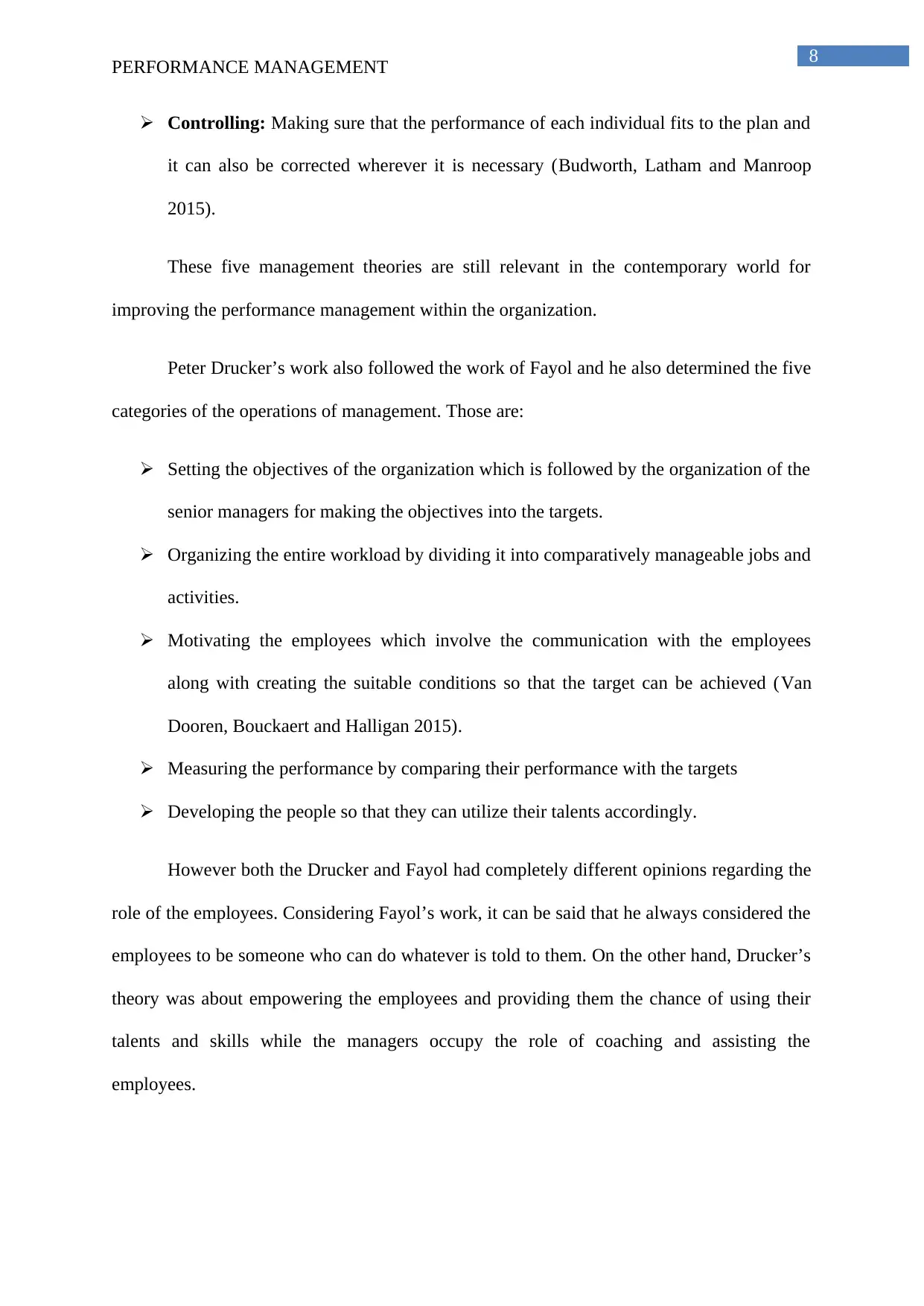
8
PERFORMANCE MANAGEMENT
Controlling: Making sure that the performance of each individual fits to the plan and
it can also be corrected wherever it is necessary (Budworth, Latham and Manroop
2015).
These five management theories are still relevant in the contemporary world for
improving the performance management within the organization.
Peter Drucker’s work also followed the work of Fayol and he also determined the five
categories of the operations of management. Those are:
Setting the objectives of the organization which is followed by the organization of the
senior managers for making the objectives into the targets.
Organizing the entire workload by dividing it into comparatively manageable jobs and
activities.
Motivating the employees which involve the communication with the employees
along with creating the suitable conditions so that the target can be achieved (Van
Dooren, Bouckaert and Halligan 2015).
Measuring the performance by comparing their performance with the targets
Developing the people so that they can utilize their talents accordingly.
However both the Drucker and Fayol had completely different opinions regarding the
role of the employees. Considering Fayol’s work, it can be said that he always considered the
employees to be someone who can do whatever is told to them. On the other hand, Drucker’s
theory was about empowering the employees and providing them the chance of using their
talents and skills while the managers occupy the role of coaching and assisting the
employees.
PERFORMANCE MANAGEMENT
Controlling: Making sure that the performance of each individual fits to the plan and
it can also be corrected wherever it is necessary (Budworth, Latham and Manroop
2015).
These five management theories are still relevant in the contemporary world for
improving the performance management within the organization.
Peter Drucker’s work also followed the work of Fayol and he also determined the five
categories of the operations of management. Those are:
Setting the objectives of the organization which is followed by the organization of the
senior managers for making the objectives into the targets.
Organizing the entire workload by dividing it into comparatively manageable jobs and
activities.
Motivating the employees which involve the communication with the employees
along with creating the suitable conditions so that the target can be achieved (Van
Dooren, Bouckaert and Halligan 2015).
Measuring the performance by comparing their performance with the targets
Developing the people so that they can utilize their talents accordingly.
However both the Drucker and Fayol had completely different opinions regarding the
role of the employees. Considering Fayol’s work, it can be said that he always considered the
employees to be someone who can do whatever is told to them. On the other hand, Drucker’s
theory was about empowering the employees and providing them the chance of using their
talents and skills while the managers occupy the role of coaching and assisting the
employees.
⊘ This is a preview!⊘
Do you want full access?
Subscribe today to unlock all pages.

Trusted by 1+ million students worldwide

9
PERFORMANCE MANAGEMENT
Performance Management and Employee Development
The term ‘performance management’ is closely related to the employee development
within any organization. Even if apparently performance management is an objective setting
method of performance appraisal procedure, an honest performance management process
should involve all of these procedures. As stated by Budworth, Latham and Manroop (2015)
the idea of performance management is significant in the system of the organization in order
to manage the employee performance, organizational performance along with integrating the
organizational management with the concept if employee performance. The concept of
performance management involves various scrutiny stages which are linked to evaluating the
human resources and the organizational performance. Performance management helps the
organization to comprehend the effectiveness of the employees. This systematic procedure
helps both the employees and the organization itself. It helps the employees by providing
individual feedbacks and helps the organization to collect the organizational data that can be
utilized in the future planning of human resources and the program evaluation. According to
Mone and London (2014) performance management is a continuous process for recognizing,
assessing and further developing the employee performance within the organization. The
initial stage of this procedure is to gather the necessary data through systematic observation
and not only for measuring the present performance of the employees, but also for providing
honest feedback to the employees so that they can improve their performance in future. The
main purpose of the performance management is to measure the improvement of the
employees by differentiating their performance level, determine their training requirements,
authenticate the rewards and identify the particular employees for further promotion. The
performance management system is an integral part of the human resources practice therefore
it has been organized that there should always be a positive link between the strategic human
resource practice and the employee performance. As per Wolpert et al. (2014)’s view, the
PERFORMANCE MANAGEMENT
Performance Management and Employee Development
The term ‘performance management’ is closely related to the employee development
within any organization. Even if apparently performance management is an objective setting
method of performance appraisal procedure, an honest performance management process
should involve all of these procedures. As stated by Budworth, Latham and Manroop (2015)
the idea of performance management is significant in the system of the organization in order
to manage the employee performance, organizational performance along with integrating the
organizational management with the concept if employee performance. The concept of
performance management involves various scrutiny stages which are linked to evaluating the
human resources and the organizational performance. Performance management helps the
organization to comprehend the effectiveness of the employees. This systematic procedure
helps both the employees and the organization itself. It helps the employees by providing
individual feedbacks and helps the organization to collect the organizational data that can be
utilized in the future planning of human resources and the program evaluation. According to
Mone and London (2014) performance management is a continuous process for recognizing,
assessing and further developing the employee performance within the organization. The
initial stage of this procedure is to gather the necessary data through systematic observation
and not only for measuring the present performance of the employees, but also for providing
honest feedback to the employees so that they can improve their performance in future. The
main purpose of the performance management is to measure the improvement of the
employees by differentiating their performance level, determine their training requirements,
authenticate the rewards and identify the particular employees for further promotion. The
performance management system is an integral part of the human resources practice therefore
it has been organized that there should always be a positive link between the strategic human
resource practice and the employee performance. As per Wolpert et al. (2014)’s view, the
Paraphrase This Document
Need a fresh take? Get an instant paraphrase of this document with our AI Paraphraser
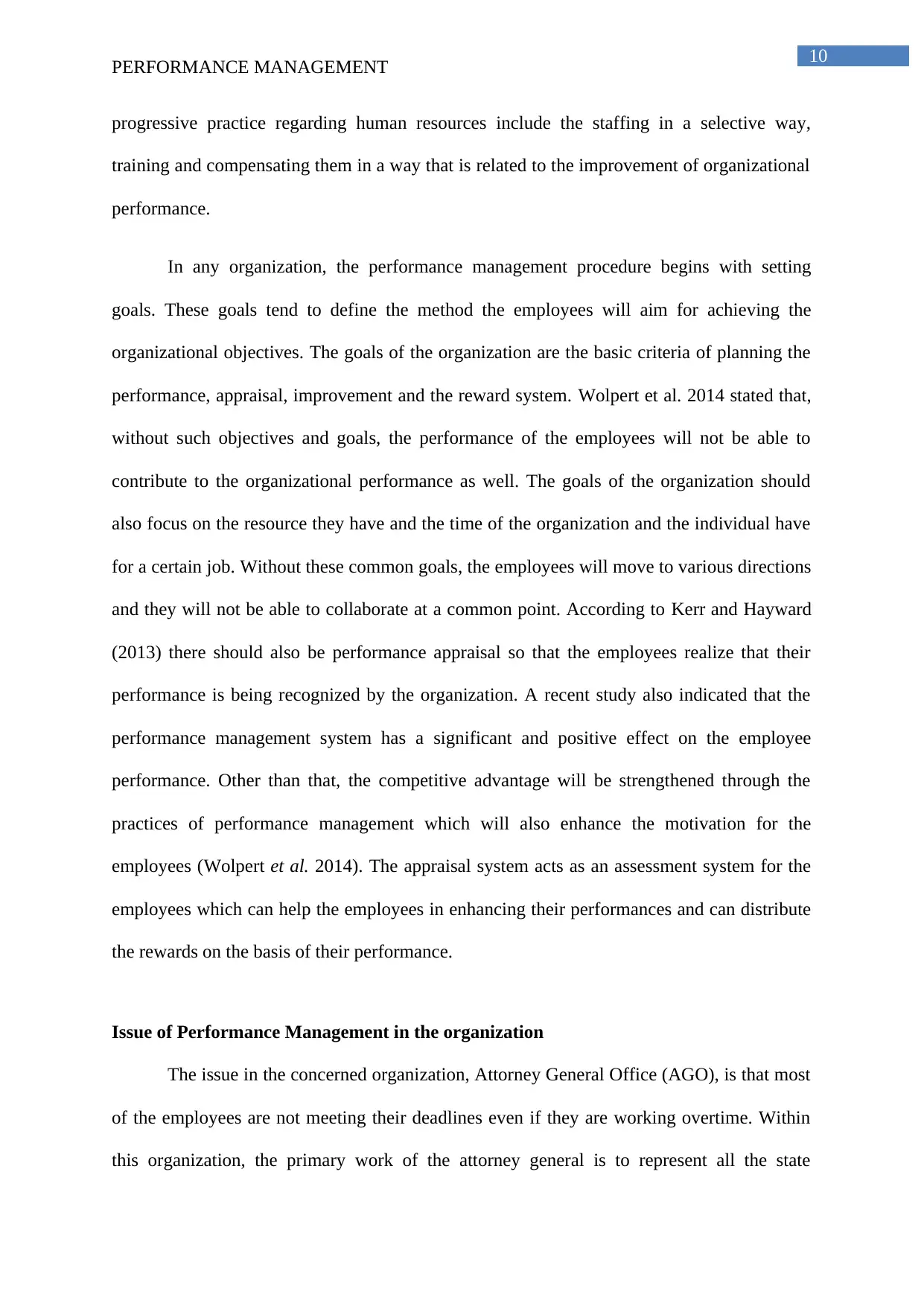
10
PERFORMANCE MANAGEMENT
progressive practice regarding human resources include the staffing in a selective way,
training and compensating them in a way that is related to the improvement of organizational
performance.
In any organization, the performance management procedure begins with setting
goals. These goals tend to define the method the employees will aim for achieving the
organizational objectives. The goals of the organization are the basic criteria of planning the
performance, appraisal, improvement and the reward system. Wolpert et al. 2014 stated that,
without such objectives and goals, the performance of the employees will not be able to
contribute to the organizational performance as well. The goals of the organization should
also focus on the resource they have and the time of the organization and the individual have
for a certain job. Without these common goals, the employees will move to various directions
and they will not be able to collaborate at a common point. According to Kerr and Hayward
(2013) there should also be performance appraisal so that the employees realize that their
performance is being recognized by the organization. A recent study also indicated that the
performance management system has a significant and positive effect on the employee
performance. Other than that, the competitive advantage will be strengthened through the
practices of performance management which will also enhance the motivation for the
employees (Wolpert et al. 2014). The appraisal system acts as an assessment system for the
employees which can help the employees in enhancing their performances and can distribute
the rewards on the basis of their performance.
Issue of Performance Management in the organization
The issue in the concerned organization, Attorney General Office (AGO), is that most
of the employees are not meeting their deadlines even if they are working overtime. Within
this organization, the primary work of the attorney general is to represent all the state
PERFORMANCE MANAGEMENT
progressive practice regarding human resources include the staffing in a selective way,
training and compensating them in a way that is related to the improvement of organizational
performance.
In any organization, the performance management procedure begins with setting
goals. These goals tend to define the method the employees will aim for achieving the
organizational objectives. The goals of the organization are the basic criteria of planning the
performance, appraisal, improvement and the reward system. Wolpert et al. 2014 stated that,
without such objectives and goals, the performance of the employees will not be able to
contribute to the organizational performance as well. The goals of the organization should
also focus on the resource they have and the time of the organization and the individual have
for a certain job. Without these common goals, the employees will move to various directions
and they will not be able to collaborate at a common point. According to Kerr and Hayward
(2013) there should also be performance appraisal so that the employees realize that their
performance is being recognized by the organization. A recent study also indicated that the
performance management system has a significant and positive effect on the employee
performance. Other than that, the competitive advantage will be strengthened through the
practices of performance management which will also enhance the motivation for the
employees (Wolpert et al. 2014). The appraisal system acts as an assessment system for the
employees which can help the employees in enhancing their performances and can distribute
the rewards on the basis of their performance.
Issue of Performance Management in the organization
The issue in the concerned organization, Attorney General Office (AGO), is that most
of the employees are not meeting their deadlines even if they are working overtime. Within
this organization, the primary work of the attorney general is to represent all the state
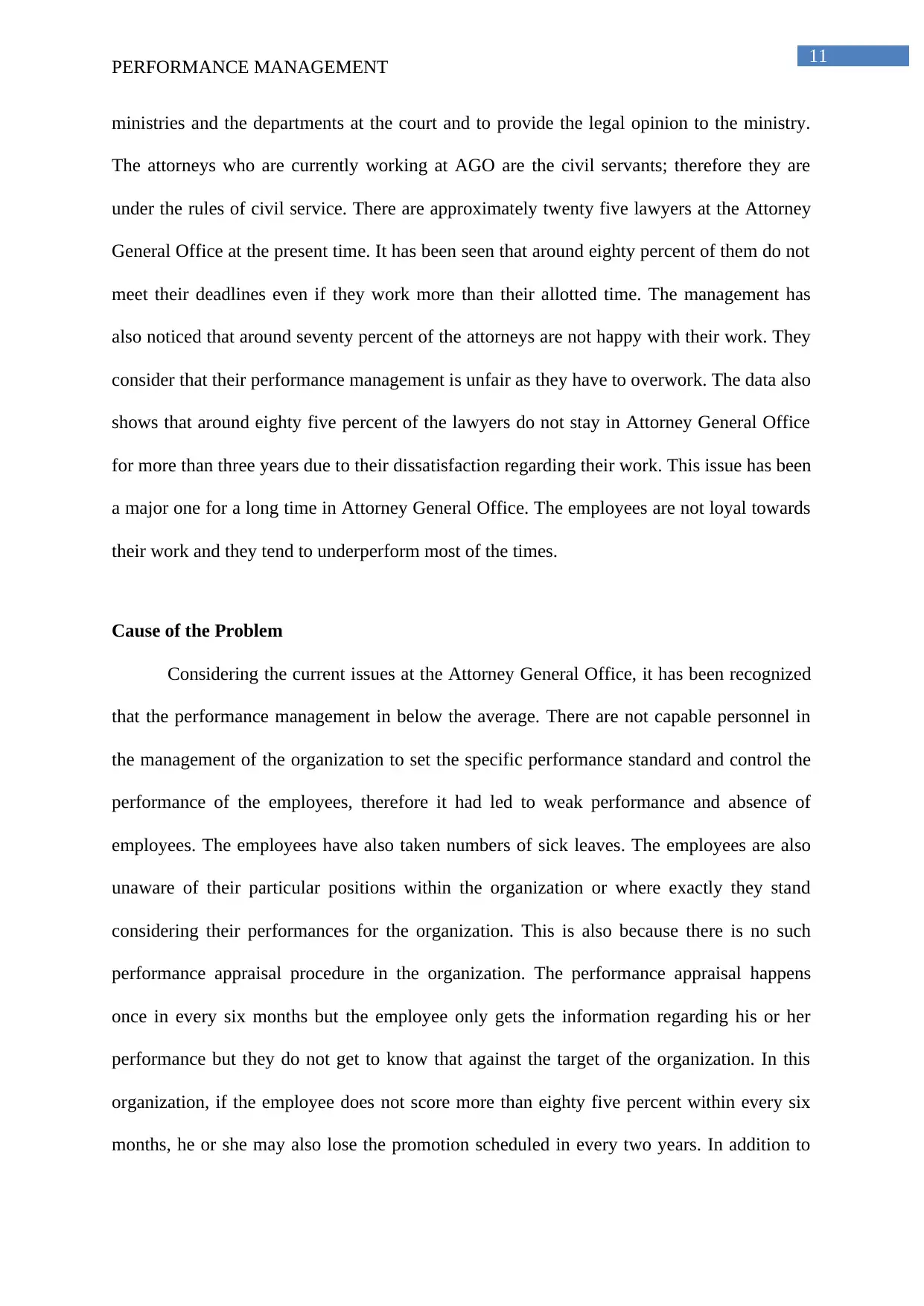
11
PERFORMANCE MANAGEMENT
ministries and the departments at the court and to provide the legal opinion to the ministry.
The attorneys who are currently working at AGO are the civil servants; therefore they are
under the rules of civil service. There are approximately twenty five lawyers at the Attorney
General Office at the present time. It has been seen that around eighty percent of them do not
meet their deadlines even if they work more than their allotted time. The management has
also noticed that around seventy percent of the attorneys are not happy with their work. They
consider that their performance management is unfair as they have to overwork. The data also
shows that around eighty five percent of the lawyers do not stay in Attorney General Office
for more than three years due to their dissatisfaction regarding their work. This issue has been
a major one for a long time in Attorney General Office. The employees are not loyal towards
their work and they tend to underperform most of the times.
Cause of the Problem
Considering the current issues at the Attorney General Office, it has been recognized
that the performance management in below the average. There are not capable personnel in
the management of the organization to set the specific performance standard and control the
performance of the employees, therefore it had led to weak performance and absence of
employees. The employees have also taken numbers of sick leaves. The employees are also
unaware of their particular positions within the organization or where exactly they stand
considering their performances for the organization. This is also because there is no such
performance appraisal procedure in the organization. The performance appraisal happens
once in every six months but the employee only gets the information regarding his or her
performance but they do not get to know that against the target of the organization. In this
organization, if the employee does not score more than eighty five percent within every six
months, he or she may also lose the promotion scheduled in every two years. In addition to
PERFORMANCE MANAGEMENT
ministries and the departments at the court and to provide the legal opinion to the ministry.
The attorneys who are currently working at AGO are the civil servants; therefore they are
under the rules of civil service. There are approximately twenty five lawyers at the Attorney
General Office at the present time. It has been seen that around eighty percent of them do not
meet their deadlines even if they work more than their allotted time. The management has
also noticed that around seventy percent of the attorneys are not happy with their work. They
consider that their performance management is unfair as they have to overwork. The data also
shows that around eighty five percent of the lawyers do not stay in Attorney General Office
for more than three years due to their dissatisfaction regarding their work. This issue has been
a major one for a long time in Attorney General Office. The employees are not loyal towards
their work and they tend to underperform most of the times.
Cause of the Problem
Considering the current issues at the Attorney General Office, it has been recognized
that the performance management in below the average. There are not capable personnel in
the management of the organization to set the specific performance standard and control the
performance of the employees, therefore it had led to weak performance and absence of
employees. The employees have also taken numbers of sick leaves. The employees are also
unaware of their particular positions within the organization or where exactly they stand
considering their performances for the organization. This is also because there is no such
performance appraisal procedure in the organization. The performance appraisal happens
once in every six months but the employee only gets the information regarding his or her
performance but they do not get to know that against the target of the organization. In this
organization, if the employee does not score more than eighty five percent within every six
months, he or she may also lose the promotion scheduled in every two years. In addition to
⊘ This is a preview!⊘
Do you want full access?
Subscribe today to unlock all pages.

Trusted by 1+ million students worldwide
1 out of 20
Related Documents
Your All-in-One AI-Powered Toolkit for Academic Success.
+13062052269
info@desklib.com
Available 24*7 on WhatsApp / Email
![[object Object]](/_next/static/media/star-bottom.7253800d.svg)
Unlock your academic potential
Copyright © 2020–2025 A2Z Services. All Rights Reserved. Developed and managed by ZUCOL.




